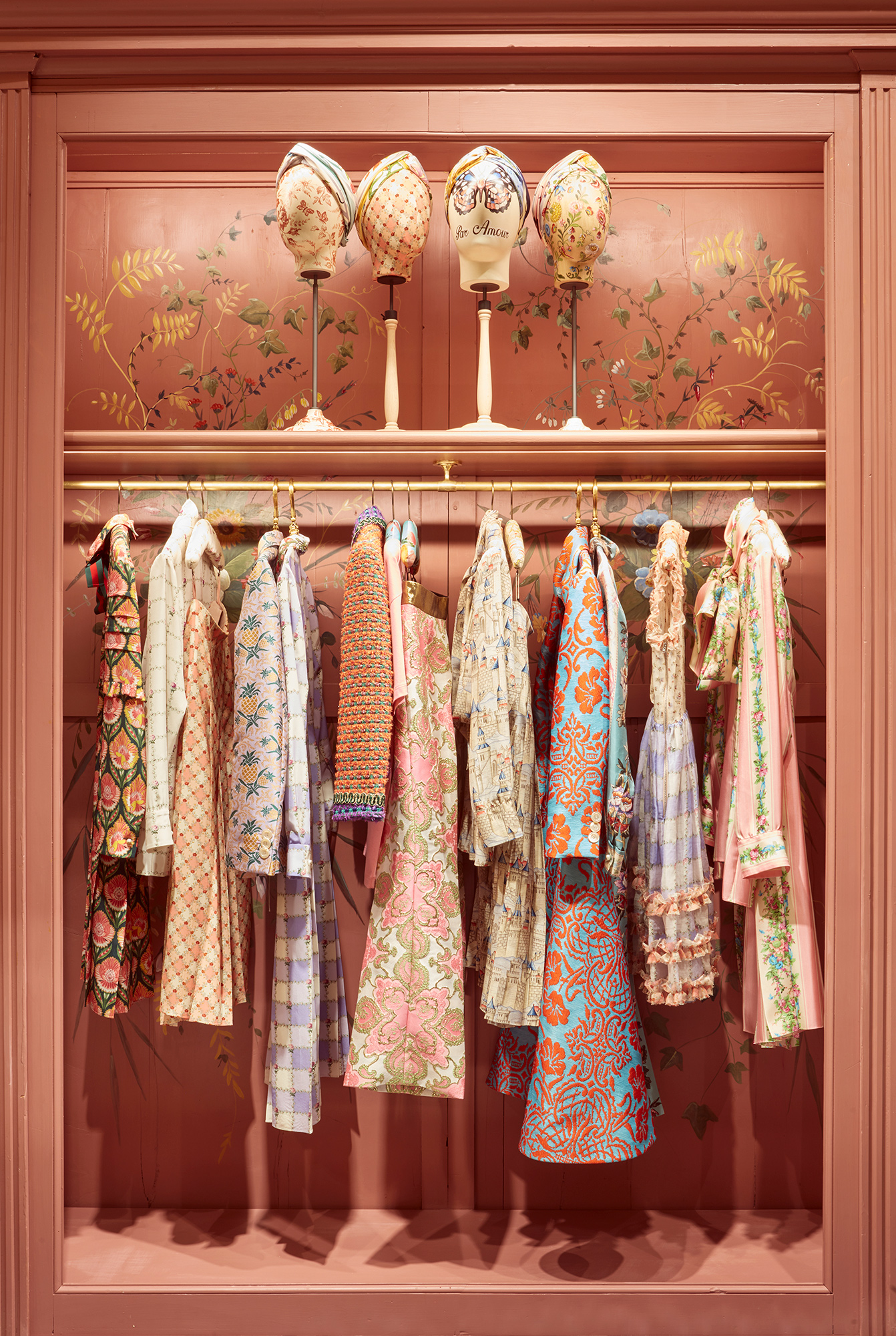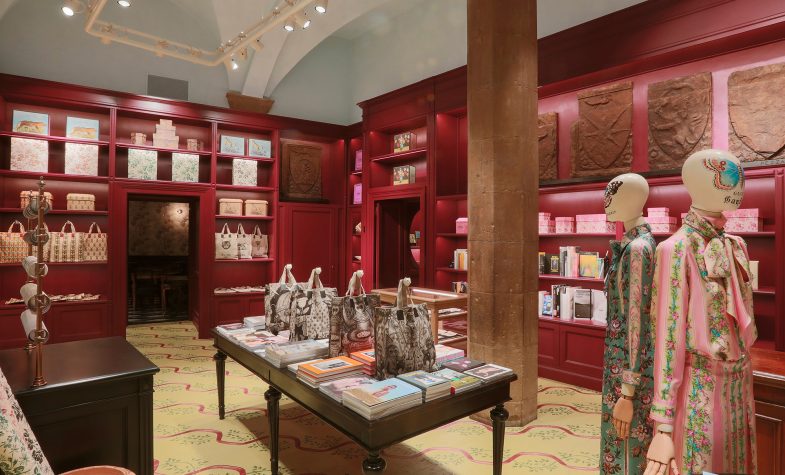WORDS
Peter Howarth
Fashion museums can often feel a bit like hard work for those who are not superfans of a particular designer, or indeed of the intricacies of clothing and accessories. Perhaps it’s because they often seem serious places where the emphasis is on the craft and workmanship behind the clothes and less on the emotions they evoke, or the cultural significance they have.
Last week, Gucci signalled the opening of its new museum, called Gucci Garden, by illuminating a giant neon eye artwork on the facade of the elegant ancient Palazzo della Mercanzia in Florence. This Florentine palazzo – which dates back to the 14th century and sits between the famous Piazza della Signoria, home of the Uffizi Gallery, and Piazza San Firenze – looks from the outside as though it might house some beautiful, if a little dusty, Renaissance treasures.
In fact, walk through the door and you find yourself in a Willy Wonka universe of Gucci patterns, colours and products. Brummell was given a sneak preview when the place was being filled with exhibits, and can safely say, as with all things Gucci these days, it pays to expect the unexpected.

Over the past three years, Gucci’s creative director Alessandro Michele (appointed in January 2015) has done his best to rewrite the rule book for a global fashion brand. His approach has been non-corporate, personal, poetic, romantic, eclectic and unpredictable. His shops feel like playgrounds for the senses, multicoloured and patterned theatrical sets for consumers to get lost in; his shows are statements of a mash-up of influences and ideas, where the Renaissance meets the Sex Pistols. And now he has taken the concept of the fashion museum and reimagined it as a living, collaborative and creative space in which to express the evolving aesthetic and philosophy of the house he works for.
Designed by Michele, the Gucci Garden is dedicated to an exploration of the vibrant creativity that lies at the very heart of the house. Through curating a wide range of pieces from collections dating back to the firm’s Florentine origins in 1921 and marrying these with recent work, memorabilia, ephemera and contemporary art, Gucci Garden is not only a celebration of a rich archive, but a lively, interactive experience.
The name Gucci Garden refers in part to Michele’s passion for incorporating references to the natural world of plants, flowers and animals into his creations. But it also has a metaphorical meaning. Michele says, ‘The garden is real, but it belongs above all to the mind, populated with plants and animals: like the snake, which slips in everywhere, and in a sense, symbolises a perpetual beginning and a perpetual return’.
Thus, the exhibits here are organised in a purposefully non-chronological way, to help the visitor explore Gucci through themes and ideas. It’s much more interesting than a history lesson, but cleverly enables Michele to draw on the archive of work and make it part of his contemporary story. The past comes alive when you see a zebra coat from the 1920s next to a modern-day orange fake-fur one with big zebra motifs. Both are equally Gucci, and putting them side by side creates a dialogue across the decades.
One room, entitled ‘Guccification’, explores the famous double-G emblem by looking at the many ways the logo mark has been transformed from its use on vintage and contemporary pieces, to the recent collaboration with New York-based artist Trevor Andrew (AKA GucciGhost), and the work of stylists such as Brit Simon Foxton, who has infused the House Gs with a punk spirit. In the Gucci Garden galleries (the ‘Gucci Garden Galleria’), a whole wall has been graffitied by GucciGhost, and this contrasts with the next room – labelled ‘Paraphernalia’ – in which one side is filled with a giant 19th-century figurative equestrian oil portrait, Fantino con bambina, by Domenico Induno. In this space, the focus is on the brand’s famous icons, such as loafers, the horsebit, the red/green/red web-striped ribbon, the distinctive, signature house prints, and the use of bamboo.
Other themes include travel and luggage, and in a room labelled ‘Cosmorama’ you find a display of unusual Gucci bags and suitcases, and a look atthe house’s origins as a maker of leather goods,as well as a study ofthe emblem of the bell boy, or lift boy, a reference to founder Guccio Gucci’s time as a porter at London’s Savoy Hotel when a young man.
Curator and critic Maria Luisa Frisa, head of the BA degree course in Fashion Design and Multimedia Arts at Iuav University in Venice, worked with Gucci’s Michele to organise the Gucci Garden Galleria, which occupy the first and second floors of the palazzo. She explains why the displays imaginatively mix objects and video content throughout.
‘We decided to make the space a laboratory where you have all the elements with which to creatively experiment,’ she says. ‘In the rooms entitled “De Rerum Natura”, for example, we see Gucci’s passion for flora and fauna expressed through vintage and current garments, silver animal statuettes made by the firm in the Fifties and original artwork by Vittorio Accornero de Testa, who was commissioned to create the Gucci Flora print in 1966.’
The Gucci Garden also has a small cinema that shows avant-garde films, and a large bazaar-like store full of items on the ground floor, designed exclusively for this location and not available elsewhere in the world. The boutique is fitted-out with restored wooden vintage furniture and display units that have been painted in bright colours. The feeling is of a grand and eccentric living space, rather than of a sales floor, where the architecture of the original building has been picked out and foregrounded through the yellow and red colour scheme of the walls and ceilings.
Notably, all Gucci designers, not just Alessandro Michele, are represented in the Gucci Garden Galleria. ‘The past is very much part of the present at Gucci, which is perfectly in keeping with Alessandro’s idea of the brand, and indeed his attitude to Florence, Gucci’s home, which he sees as a city where history is still vibrantly alive,’ explains curator Frisa.
In keeping with the spirit of collaboration that Gucci Garden embraces, chef Massimo Bottura has been invited to open an intimate restaurant on the ground floor, the Gucci Osteria. Bottura is internationally famed for his three-Michelin-star Osteria Francescana, which sits just over the Tuscan-Emilian Apennines, in the heart of Modena. For Gucci Garden, he has created an entirely new menu that fuses Italian cuisine with inspiring elements from Bottura’s travels. ‘Travelling the world, our kitchen interacts with everything we see, hear and taste,’ says Bottura. ‘With eyes wide open, we look for the unexpected and next éclat.’ The menu includes iconic Italian dishes as well as conceptual twists on classics for an all-day dining experience.
‘The restaurant is a reminder that Florence has always been a centre of cultural exchange, particularly during the Renaissance,’ says Bottura. To reinforce this idea, lines of a 15th-century carnival song, or “canto carnascialesco”, by Lorenzo de’ Medici – Canzona of the seven planets, or Canzona de‘ sette pianeti – are written in gold letters around the tops of the walls of the Gucci Osteria.
As if to underscore the company’s love of its birthplace, 50 per cent of the €8 entry price is being donated to support restoration work in the city of Florence.
The Gucci Garden is at the Palazzo della Mercanzia, Piazza della Signoria, 10, 50122 Florence, Italy; gucci.com












